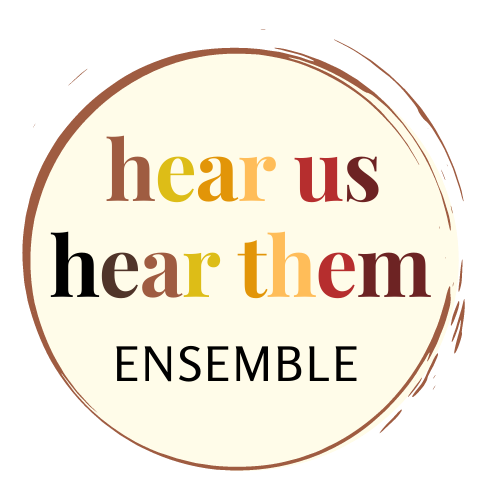A Conversation with Molly Joyce, composer
Hear Us, Hear Them Education Manager, Taylor Adams spoke with composer Molly Joyce. As part of our spring concert, we are excited to present her piece Glow. This piece, originally premiered by the The New York Virtuoso Singers in 2015, features evocative text written by Molly Joyce and Caitlin Kenzie Scott.
Molly is a composer and performer whose works feature astonishing creativity. From her website: “Her work is concerned with disability as a creative source. She has an impaired left hand from a previous car accident, and seeks to explore disability through composition, performance, collaboration, community engagement, and further mediums. Her most recent album, Perspective, featuring forty-seven disabled interviewees responding to what access, care, interdependence, and more mean to them, was released on October 2022 on New Amsterdam Records.”
Thank you to Molly for her time and music. To learn more about her and her work, please visit her website.
“Glow aligns with our theme of Resounding Peace because of the writers' connection to positive memories and the glimpse of light piercing through the shadows of night. Joyce brilliantly relates light, dreams, and memory (the intangible) to bone and ‘hummingbirds beating in my ribs’ (the physical). The piece is beautiful in allowing the singer/listener to interpret the deepest meanings of this personally and uniquely. Overall, “Glow” speaks to a desire to see the light through whatever dismal circumstance you are experiencing.”
– Harry Mathurin-Cecil, Artistic Director
What do you find powerful about reclaiming/reframing/redefining language?
Everything and anything - the power to view language as an imaginative rather than restrictive space. Specifically, the power to redefine false normatives and perceptions in our world and critically construct them towards more positive forces.
What do you feel like is the relationship between creative expression and having an explicit purpose or goal in your art (if there is one)?
My practice focuses on disability as a creative source. This focus stems from my direct, embodied experience acquiring a disability at the age of seven, and since then journeying from denying to embracing my disability first and foremost. With this process, I have discovered disability as a rich and generative artistic source, ranging from exploring narrative expression related to the experience of acquiring a disability, to communally-engaged projects highlighting voices and viewpoints of disabled individuals, to music technology exploring adaptive means of performing music.
Your works are highly collaborative–how do you pick/seek out collaborators or projects to collaborate on? When do you realize that one of your ideas may even need collaboration? What does that creative process feel like as opposed to creating something more solitary? How do you engage with unspecified or open-ending collaboration, where others’ work is less predictable?
Typically my collaborations/collaborators have come naturally, either through mutual connections and/or interest in each other's work. Usually, my projects from the start have an idea of collaboration, whether with another artistic discipline or music performers. Sometimes, near the end of my creative process it is clear that a collaborator is necessary, such as for sound mixing or video filming. Collaborating certainly feels more communal than solo composing/performing. Also, it encourages me to open up to new perspectives and seek the value of creating something I could not have done by myself. My collaborations certainly vary but I usually try to establish processes that allow for artistic freedom yet also the structure of responding to each other's work. For example, in a video/dance work titled Left and Right, there were three primary creatives, a dancer (Jerron Herman), audio describer (Max Greyson), and composer (myself). For the creative process, there were three sections in the work and we alternated which discipline would come first in each section, and then trade off from there to create our part in response to each other, therefore giving us creative freedom at the start for one section and also an opportunity to respond to each other's work.
How do you tap into and replenish your creativity?
Anything and everything, usually seeing/hearing/visiting other art, traveling, time with friends/family, and exercise.
When we talk about “diversifying the canon,” we often talk about increasing the audiences that have access to spaces like concert halls and opera houses. I noticed many of your projects, however, aren't necessarily bound by these spaces. For example, the Perspective project has had several iterations in different types of spaces and can be engaged with online. What is your relationship to physical space when creating?
It depends on the project, but I like to view my projects as flexible in terms of presentation and medium. Especially as a disabled artist, I strongly consider accessibility in my work and reaching audiences beyond physical location, as well as the physical accessibility of a space and how to create a welcoming and inclusive environment.
Favorite song from Beyonce's Renaissance? Favorite song on the Taylor tour?
Break My Soul! I'm seeing Taylor Swift next month and can let you know :)
Anything upcoming that you’re excited about and able to share?
I'll be doing a public art iteration of the aforementioned project Perspective in Dusseldorf, Germany over this coming year which I'm very excited about. It will feature disabled interviewees from Dusseldorf as well as explore public installation opportunities for the work, such as with billboards. Here is the press announcement.

